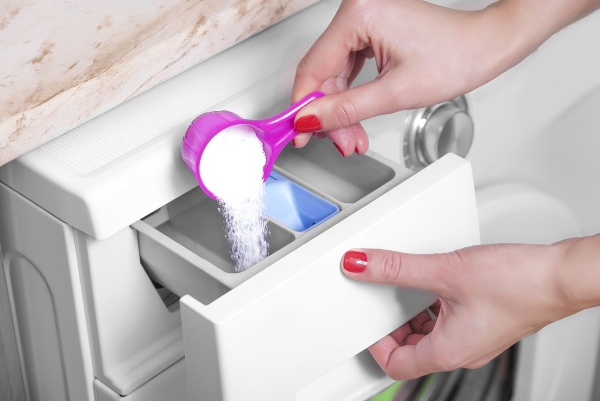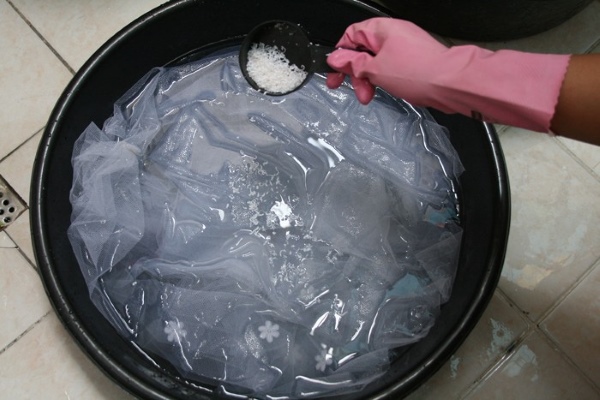How and with what can you bleach tulle?
How to remove yellowness and grayness?
Tulle is practical to use and gives a special touch to the room. The zealous owners use the slightest opportunity to restore the whiteness of the tulle products on their own. To whiten the tulle, they use the achievements of modern science or products proven by the skills of previous generations.Before bleaching, the tulle must be shaken off from the settled dust. Soak it in a warm solution of any soap, wash. Instead of soap, you can use washing powder. After washing, rinse with plenty of clean warm water.
The use of very hot water will give the tissue yellowness, which will be problematic to remove later.
Folk remedies
With salt:- Place the tulle at the end of washing and rinsing for 3 hours in a solution of table salt (dissolve salt in water at the rate of 250 g of table salt per 1 liter of water). Rinse 2-3 times in clean cool water.
- Dissolve 100 g of detergent for washing and 100 g of rock salt in 1 liter of hot water. Bring the prepared composition to a warm state by adding cold water. Soak the tulle for 12 hours. Wash and rinse with plenty of clean water. After such bleaching, the tulle becomes bright white.
Since the chemical composition of blue (powder or liquid) contains not only dyes, but also stain removers, blue is used to restore the whiteness of nylon tulle. A faint shade of blue will only accentuate the whiteness.
In 12 liters of water, dissolve 5 g of blue powder or half a cap of the liquid fraction. In such a solution, the tulle product is rinsed at the end of the main wash. At the end of the blue rinse, rinse the tulle in clean water.
Brilliant green:
The usual pharmacy "green" is not only a good antiseptic, but also an excellent bleaching agent for nylon tulle. In large quantities it is a difficult to wash off dye, in small quantities it is an excellent bleach. 10 drops of "green" are initially dissolved in 200 ml of water at room temperature. The solution should stand for 30 minutes.
Upon completion of the ordinary wash, the tulle is soaked in 12 liters of warm water mixed with the prepared solution of "green stuff". It is necessary to make sure that the sediment of the "green stuff" in the aqueous solution does not get into the container prepared for bleaching. Constantly turning the tulle over, after 10 min. hang to dry without spinning.
How to bleach tulle at home using salt and brilliant green You can find out by watching the presented video.
Pharmacy potassium permanganate:
Add a pre-prepared saturated aqueous solution of potassium permanganate to a solution of laundry soap (for quick dissolution, you can grate it) add a saturated aqueous solution of potassium permanganate (all grains should melt). The resulting mixture has a light pink tint with a lather. The tulle is soaked in an emulsion liquid for 40 minutes. Then they wash and rinse as usual.
Potato starch:
Stir 300 g of potato starch in 12 liters of water. Soak the previously washed and dried tulle in the resulting solution for 4.5 hours. After the soaking time, pull out the tulle, let it drain and without wringing, hang it on the window to dry.
Baking soda:
Baking soda bleaching is used as an additional soak before washing. Mix 10 liters of warm water, 100 g of detergent and 40 g of baking soda. Place for 30 minutes. into the produced tulle solution. Washing is best done by machine with an additional rinse.
You can familiarize yourself with another effective method of tulle bleaching using soda by watching this video.
Soda ash:
Dissolve 25 g of soda ash and 15 g of hydrogen peroxide in 2 liters of warm water. Soak the tulle for 2 hours with constant turning. After soaking, rinse thoroughly several times in water. Dry without squeezing.
Hydrogen peroxide and ammonia:
The combination of these two components is an excellent bleach for both nylon and cotton tulle.
- Fast method. 50 g of hydrogen peroxide (pharmacy version - 3%), dilute 25 g of ammonia with 10 liters of hot water. Soak the cloth for 40 minutes, turning it over from time to time with wooden tongs or a stick. After the specified time has elapsed, rinse thoroughly in water without squeezing and hang to dry.
- Night way. Prepare a solution of 5 liters of non-cold water and 150 g of ammonia. Leave the soaked cloth for 10-12 hours. Then rinse thoroughly in warm water. Hang up without squeezing for airing and drying.
For washing and soaking nylon tulles, use water not higher than + 30 ° C.
The use of factory bleaching products
The modern industry presents several options for bleaching agents. By composition, they are divided into the following:- bleach "Whiteness";
- bleach "Vanish";
- ACE;
- "Nanny".
After the application of "Whiteness" bleach, the tulle fabric may stop "reacting" to softer bleaches.
2. Oxygenated. Most effective for bleaching nylon tulle. The main ingredient is hydrogen peroxide. In combination with other washing components, it is recommended for bleaching in washing machines. Their representatives:
- liquid bleach "BOS";
- "Cashmere";
- Lavadia White;
- Oxygen bleach.
- "OV-1";
- "QUANTEX";
- Irgafos 168 FF;
- "CBS-X".
When buying bleach, read carefully the recommendations for use for tulle fabrics. Stick to them strictly.
How to bleach tulle in a washing machine?
It is recommended to bleach tulle in a washing machine with the addition of a bleaching agent in the powder for washing.
Liquid bleach can be added after filling the machine drum with water. A good practice is to soak the tulle in a bleach solution before washing.
When bleaching tulle in a washing machine, you must adhere to certain rules:
- thoroughly shake the tulle from settled dust before loading it into the drum of the washing machine;
- it is better to fold and pack tulle products in a transparent bag and in no case crumple;
- Pour powder and bleach into different compartments for detergents;
- do not often use chlorine-containing bleaches, because their regular use leads to an increase in yellowness on the tulle;
- whitening and washing should be carried out in the "delicate" mode with a heating temperature not higher than + 40 ° С;
- do not bleach nylon tulle fabrics together with cotton;
- it is not recommended to use the "spin" function with the machine bleaching method.
How to bleach old tulle?
The snow-whiteness of the old tulle can be restored using the complex of the methods described above. If the fabric is cotton, the boiling method has worked well.In the selected container, grate on a grater of laundry soap at the rate of 100 g per 10 liters of water. After immersing the tulle in water, put on fire and after the soap has completely dissolved, boil for 1 hour. Rinse well alternately in saline and starch solution. Then the fabric will return to its former whiteness.
If it is nylon fabric, it cannot be digested. Using the recipes mentioned above for using hydrogen peroxide, ammonia and saline solutions, you can get good results. To restore the previous snow-white color, it is advisable to use industrial bleaching agents.
When using bleaches to restore the original color of the tulle, follow the recommendations on the package.
Features of bleaching depending on the material of the tulle
Lightweight, with a mesh or patterned structure, transparent tulle is made from various materials: silk, cotton, polyester and many others. Different types of fabrics require individual bleaching.Capron. The nylon tulle fabric is characterized by its lightness, airiness and durability. Capron shows its "character" when whitening. The best bleaching method is to use table salt.
Veil. This fabric has a matte sheen and is soft to the touch. This thin tissue is very sensitive to chemicals. For whitening, it is better to use saline solution, blue, "brilliant green".
Organza. Such a fabric has increased rigidity compared to a veil. It is better to use oxygen-containing household chemicals and folk methods for bleaching tulle using starch and blue for bleaching.
Micro veil. In terms of rigidity, the fabric occupies an intermediate line between the veil and the organza. All popular types of whitening are suitable.
Polyester. Tulle made of this material has increased strength and softness. Hot water is not recommended for bleaching. Repeated use of chlorine-containing bleaching agents affects the durability and preservation of the original whiteness of the fabric. The most positive results are usually obtained with the use of saline solutions, ammonia and hydrogen peroxide.
Regardless of what material the tulle is made of, it must be washed before bleaching.
Safety precautions when bleaching tulle
Using a large number of preparations and whitening products, you must adhere to very simple personal safety requirements:- use a plastic or metal enamelled container for bleaching;
- perform all work with gloves;
- hydrogen peroxide and chlorinated water are not compatible, so use purified water;
- when using household chemicals, strictly adhere to the dosage indicated on the package.

Also, mixing of pharmaceutical preparations should not be allowed:
- a combination of soda and ammonia or household chemicals emit vapors harmful to humans;
- soda and brilliant green neutralize each other;
- "Brilliant green" and hydrogen peroxide also neutralize each other.
